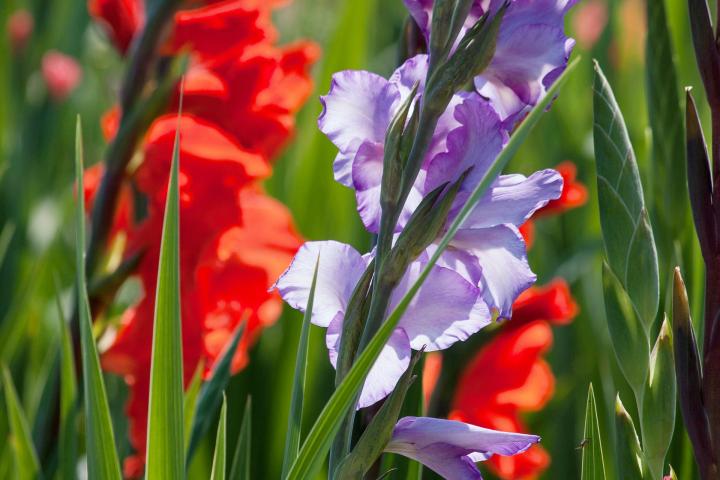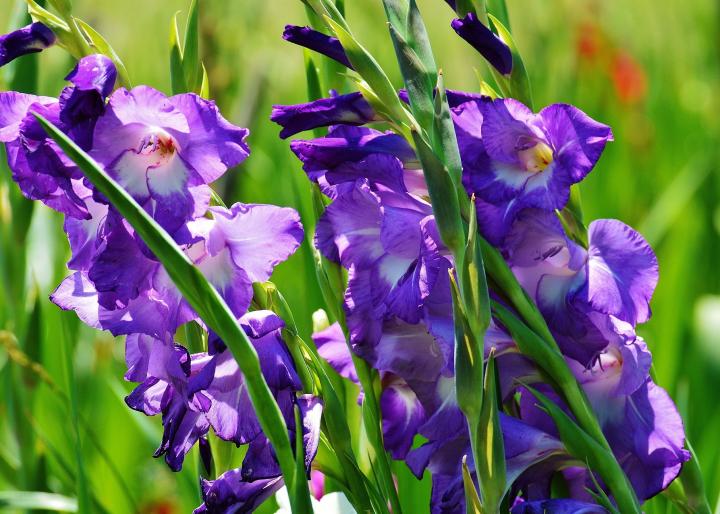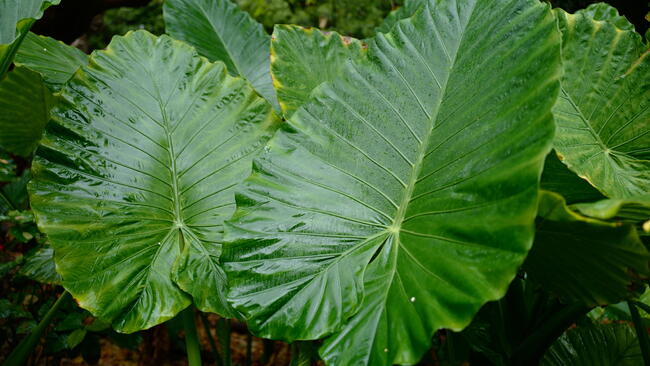
Plant gladiolus to enjoy bold blooms and beautiful summer bouquets.
Read Next
Types
Gladioli come in a variety of sizes and colors, with the most popular being part of the following hybrid groups:
- Grandiflora Hybrids: These are the classic gladioli that produce a plentiful amount of large (5- to 6-inch) blooms in a range of colors. The plants produce flower stalks that reach up to 4 feet in height and are winter hardy to Zone 7.
- Dwarf Grandiflora Hybrids: These miniature glads are an excellent choice for containers and cutting gardens, as their flowers are about half the size of Grandifloras, and their shorter stalks don’t typically require staking. They are also winter hardy to Zone 7. Glamini gladioli are included in this group; they are pest-resistant and will bloom in full sun or partial shade.
- Nanus Hybrids: Hardy to Zone 5, these smaller gladioli look a lot like Grandifloras, but do not produce as many flowers. They tend to grow no larger than about 2 feet in height, which makes them perfect for containers or small spaces.
Some specific gladiolus varieties of note include:
- ‘Black Star’ has deep purple-red blooms
- ‘Candyman’ for its beautiful, deep pink flowers
- ‘Costa’ sports ruffled flowers in blue-purple
- ‘Dream’s End’ makes a good background plant because its flower spike is up to 3 feet tall (and it has pretty light orange flowers with large yellow centers)
- ‘Fun Time’ has yellow flowers edged with red
- ‘Green Time’ for its unusual lime-green flowers
- ‘Prins Claus’ has white flowers with splashes of pink on its petals
- ‘Priscilla’ produces off-white flowers with a yellow center and a pink edge
Gardening Products
More Like This
Hmm. We're stumped! Rabbits can sometimes clip flowers or buds off and just leave them, but at 5 feet, that's unlikely without bending the plant; they normally feed up to about 2 feet high. Do you think it might be a bird? We haven't come across any gladiolus pest that would do this at that height (without major damage). Voles aren't good climbers, but can sometimes climb trees a tiny bit if there are low-hanging branches. Mice are good climbers, but their damage in the garden is usually just a few inches aboveground or belowground (although, there are some mice, such as the harvest mouse in England, that can use their tail to help climb tall stems of plants such as cereal grains or reeds). Squirrels can do the damage you describe--do you think a young squirrel, or, if they are in your area, a smaller type of squirrel such as a red squirrel, would be able to climb the gladiolus without bending it too much? Are there chipmunks in your area? Perhaps you can call your county's Cooperative Extension (if you are in the United States); they would know what pests are likely in your area, and perhaps can suggest some possibilities. For contact information, see: http://www.almanac.com/content/cooperative-extension-services Good luck!
It is possible that the south side of the house has created a microclimate that is warm enough for them to survive the winter. Also, you might have a variety that is a little more cold tolerant than others. You might add some winter protection, such as a thick layer of straw in fall, just in case, if you prefer not to dig them up for winter storage. As to when to transplant, the best time is in early spring.
- « Previous
- 1
- 2
- …
- 10
- Next »












Comments